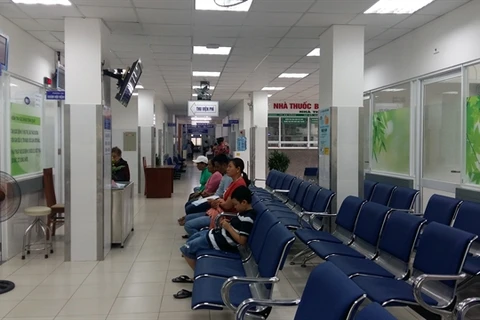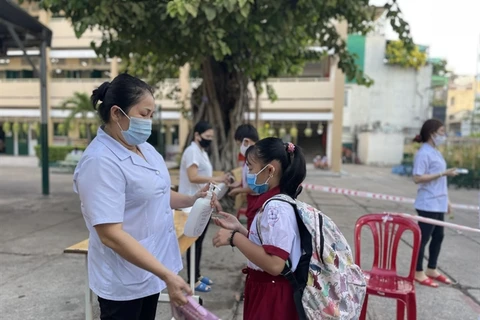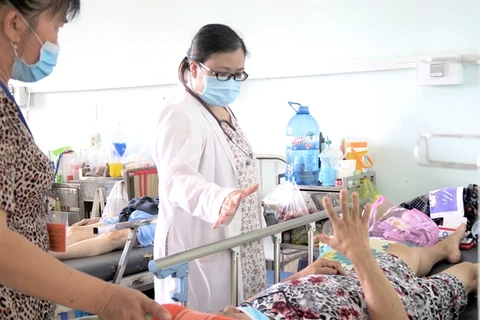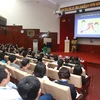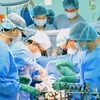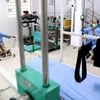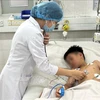Hanoi (VNS / VNA) - Vietnam records about 200,000 stroke patients every year, said Associate Professor Nguyen Trong Luu, Vice President of the Vietnam Association for Rehabilitation.
The serious, life-threatening condition ranks as the second most common cause of death in the country.
According to the doctor, a stroke occurs due to two main causes. One is a rupture of a blood vessel in the brain, most commonly due to paroxysmal hypertension. And the second is due to a blood clot or atherosclerotic clot moving in the blood stream encountering an artery of small size, with the blocked artery causing cerebral ischemia and cerebral infarction.
Previously, brain stroke often occurred in the elderly due to cerebral ischemia and bleeding in the brain, but recently stroke patients are increasingly young.
The main reason is hypertension – the leading cause of stroke – among the young.
As people’s living standards have improved dramatically, the use of alcohol drinks and high protein foods among young people has also increased which in turn heightens the risk of blood fat, and over time, there is a peril of atherosclerosis and hypertension.
In addition, elevated work pressure and the lack of exercise easily cause obesity. All of these factors increase the risk of high blood pressure that make stroke more likely.
Luu also stressed that as the number of people having a stroke was increasing, post-stroke interventions were very important to help patients return to normal life.
Statistics show that up to 80% of stroke patients suffer sequelae with severe damage and 30% of them cannot recover.
"Therefore, patients need rehabilitation and durable exercise to increase the chance of recovering from sequelae," Luu said.
After getting a stroke, patients often experience sequelae of movement disorders such as paralysis, cognitive disorders, difficulty in eating and drinking. After a stroke, patients also may have psychological, emotional and sexual function disorders.
“Stroke is one of the diseases with a high demand for rehabilitation training,” said Luu.
“This is considered a multi-disabled disease because there are many different forms of disability in a stroke patient, so recovery methods must be diverse and multimodal including drugs, surgical interventions, rehabilitation interventions by machines and hands combining with exercises in many stages,” said the doctor.
"Therefore, stroke patients need to access rehabilitation as soon as possible, right after treatment. The ideal time is in the first six months after having a stroke," he recommended.
According to the Ministry of Health, the need for rehabilitation in Vietnam is widespread due to an ageing population and the high percentage of people with disabilities.
The Ministry of Health estimates that there are more than 30 million people in need of rehabilitation, most of whom are in the age group of 50-59 and suffer from musculoskeletal disorders.
The demand for rehabilitation is strong, but only about 40% of people have access to rehabilitation services, according to a survey by the ministry in 2020.
So the ministry has set a target to raise this rate to 80% by 2030.
The World Health Organization divides the rehabilitation process for stroke patients into four stages.
The patients enter the early recovery phase after the first 48 hours of life-saving priority.
The second phase, which takes place after 48 hours to three months, is the "golden" phase.
The next phase takes place three to six months after the stroke, also a good but slower recovery period.
After six months, the patient moves to the chronic stage.
"After one year, the damages caused by the stroke are basically formed so the ability to recover is not much, but there is still a chance," Luu said.
"Therefore, patients need to do exercises to have a healthier life," he added./.
The serious, life-threatening condition ranks as the second most common cause of death in the country.
According to the doctor, a stroke occurs due to two main causes. One is a rupture of a blood vessel in the brain, most commonly due to paroxysmal hypertension. And the second is due to a blood clot or atherosclerotic clot moving in the blood stream encountering an artery of small size, with the blocked artery causing cerebral ischemia and cerebral infarction.
Previously, brain stroke often occurred in the elderly due to cerebral ischemia and bleeding in the brain, but recently stroke patients are increasingly young.
The main reason is hypertension – the leading cause of stroke – among the young.
As people’s living standards have improved dramatically, the use of alcohol drinks and high protein foods among young people has also increased which in turn heightens the risk of blood fat, and over time, there is a peril of atherosclerosis and hypertension.
In addition, elevated work pressure and the lack of exercise easily cause obesity. All of these factors increase the risk of high blood pressure that make stroke more likely.
Luu also stressed that as the number of people having a stroke was increasing, post-stroke interventions were very important to help patients return to normal life.
Statistics show that up to 80% of stroke patients suffer sequelae with severe damage and 30% of them cannot recover.
"Therefore, patients need rehabilitation and durable exercise to increase the chance of recovering from sequelae," Luu said.
After getting a stroke, patients often experience sequelae of movement disorders such as paralysis, cognitive disorders, difficulty in eating and drinking. After a stroke, patients also may have psychological, emotional and sexual function disorders.
“Stroke is one of the diseases with a high demand for rehabilitation training,” said Luu.
“This is considered a multi-disabled disease because there are many different forms of disability in a stroke patient, so recovery methods must be diverse and multimodal including drugs, surgical interventions, rehabilitation interventions by machines and hands combining with exercises in many stages,” said the doctor.
"Therefore, stroke patients need to access rehabilitation as soon as possible, right after treatment. The ideal time is in the first six months after having a stroke," he recommended.
According to the Ministry of Health, the need for rehabilitation in Vietnam is widespread due to an ageing population and the high percentage of people with disabilities.
The Ministry of Health estimates that there are more than 30 million people in need of rehabilitation, most of whom are in the age group of 50-59 and suffer from musculoskeletal disorders.
The demand for rehabilitation is strong, but only about 40% of people have access to rehabilitation services, according to a survey by the ministry in 2020.
So the ministry has set a target to raise this rate to 80% by 2030.
The World Health Organization divides the rehabilitation process for stroke patients into four stages.
The patients enter the early recovery phase after the first 48 hours of life-saving priority.
The second phase, which takes place after 48 hours to three months, is the "golden" phase.
The next phase takes place three to six months after the stroke, also a good but slower recovery period.
After six months, the patient moves to the chronic stage.
"After one year, the damages caused by the stroke are basically formed so the ability to recover is not much, but there is still a chance," Luu said.
"Therefore, patients need to do exercises to have a healthier life," he added./.
VNA

